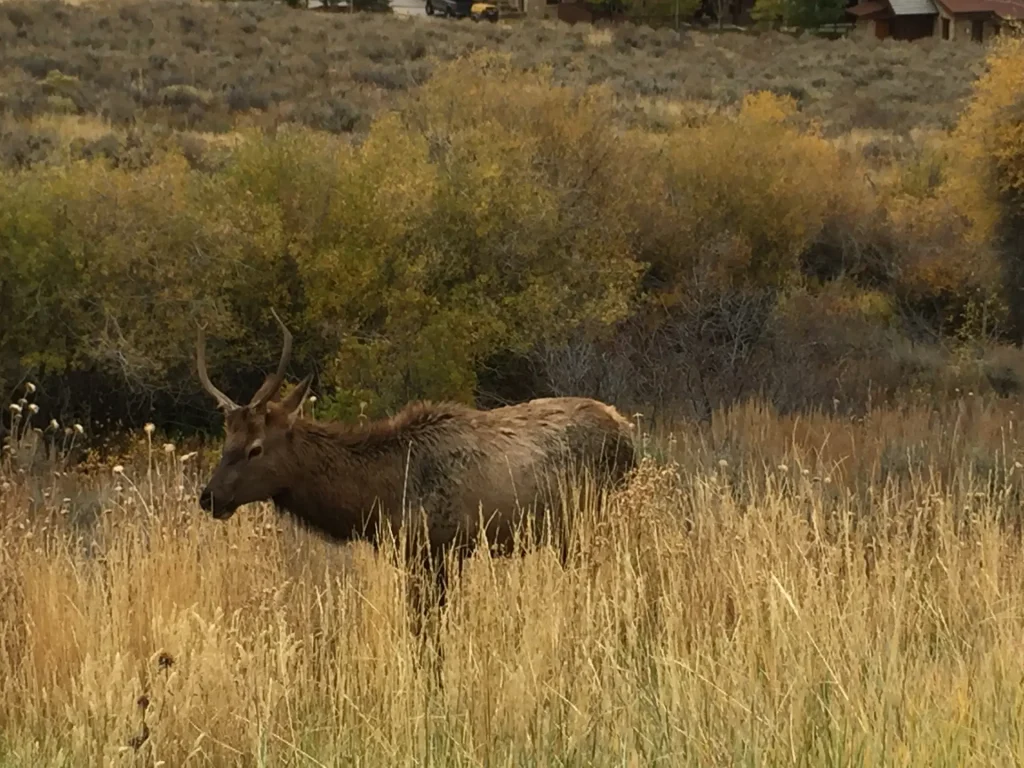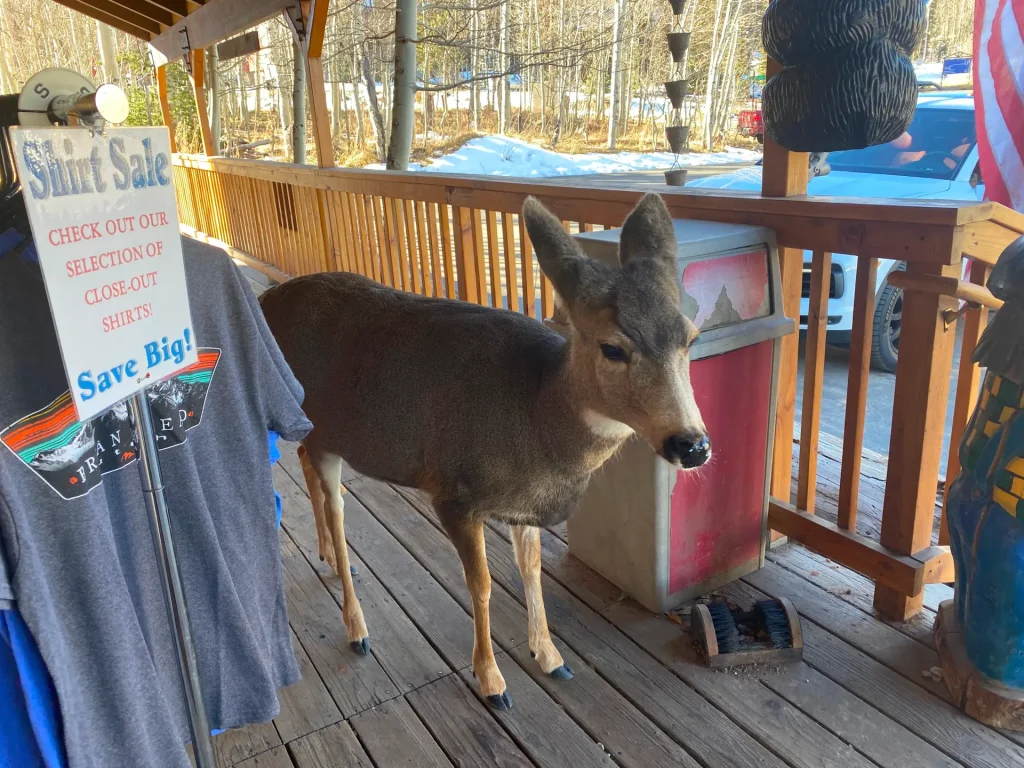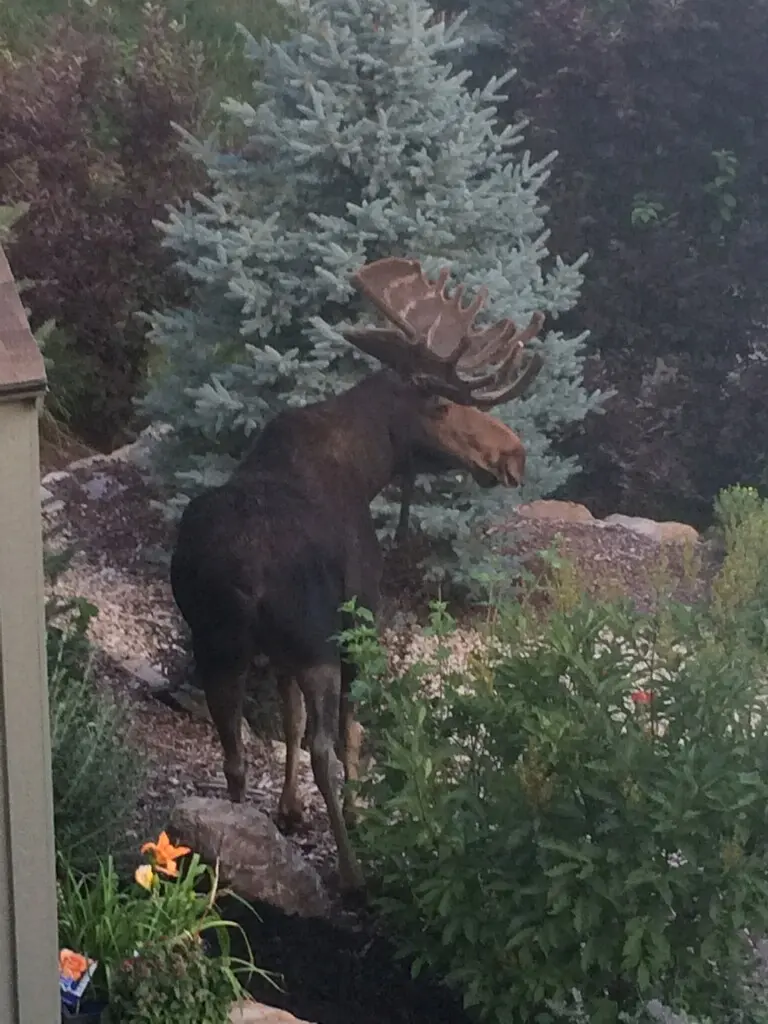Updated June 17, 2025
Anyone who has spent a fair amount of time in Park City will have wildlife stories to tell. Our town is completely surrounded by open space, and every now and then, someone will post a photo of a moose walking down Park City’s Historic Main Street. If you spend time outside, you are bound to encounter some of Park City’s furry neighbors. Now that more people have Ring and other types of cameras, wildlife sightings seem to be more commonly reported.
Possible Wildlife Encounters in Park City
What wildlife might you encounter in your Park City endeavors? More than likely, you won’t encounter much wildlife because these animals don’t want human encounters. But never say never. It’s good to know what’s lurking about when you’re hiking, biking, or having a picnic. Here’s a compilation of info from reputable sources like the USDA and Wild Aware Utah.
Bats
These mammals can be found throughout Utah, nesting in caves, trees, leafy plants, rock cliffs, and more. According to Wild Aware Utah, only a small percentage of bats carry rabies, and they typically do not bother humans.
Bears
Black bears are not always black. They can be reddish or light brown, as well. They are nocturnal and dormant in the winter, but it’s good to stay alert, especially at dawn and dusk. Make noise in wooded areas and always keep scented food items secured. Your behavior is important not only for your safety but also for that of the bears because they have great memories and will come back to where they found food in the past.
Almost every year I have lived here, there has been a bear sighting in a backyard. On occasion, a smart bear figures out which day is trash day and roams a neighborhood looking for something to eat. These bears are usually picked up by the Department of Wildlife Resources (DWR) and relocated.
Beavers
I’ve always found beavers to be amazing creatures. They can change the landscape around them with just the tools they were born with. It’s best to avoid encounters because if they feel threatened, beavers will stand their ground and could attack.
Bobcats
Bobcats are nocturnal, so it is unlikely you will see one while hiking. In a very rare encounter, be sure to protect your children and pets while backing away from the bobcat slowly and avoiding running. Make lots of noise, and if possible, spray the animal with water.
Coyotes & Foxes
It’s not extremely uncommon to hear a coyote’s howl, especially in the quieter areas of Park City. My first Park City home backed to open space, and one year, we were awakened by a crying unlike any I have heard before. We learned it was a mama coyote calling to her pups, alerting them to food in her den. We heard them year after year, but never saw them. We did, on the other hand, see occasional foxes in our backyard and believe there may have been a nearby den. Foxes in this area might be red or grayish.
Coyotes and foxes are opportunistic, and while they normally feed on small mammals, they will also eat trash or pet food. Coyotes are rarely dangerous to people unless they become habituated. So, remove all food attractants, trim vegetation, and consider a motion light if you fear coyotes are becoming problematic. If you have a small dog, make sure it is always supervised when outside.
Elk
Utah’s state mammal is a sight to behold. They live quite high in the summer and migrate lower in the winter. We have some huge elk herds come through various neighborhoods in Park City, often seen from main roads. The day I moved into our Park City home, the movers spotted a herd of elk on the hillside above our house. That same herd returned every year around Christmas and disappeared to higher ground in the summer. If you do encounter an elk, keep your distance and recognize the signs of agitation: ears back and stomping hooves.

Ermine
Ermines are part of the weasel family. The first time I saw one of these creatures, I had no idea what it was. Pure white in the winter, and light brown in the summer, they were once trapped for their fur. They are pretty cute, with their elongated bodies, but don’t let their cute looks fool you. They are carnivores and prey on voles, mice, and even rabbits.
Mountain Lions
Also called cougars, these stealthy creatures are rarely seen by humans, but they do live here. If you see one, never run. Running could provoke their prey response. The best thing to do is to make yourself look bigger by raising your bike or opening your jacket. Make eye contact, pick up children, and don’t turn your back to them. In the extremely rare instance you are attacked, fight back while protecting your neck and head.
Mule Deer
Spotting a deer might not be exciting to some, but it’s good to keep a few things in mind. First, don’t let your dog harass deer. It’s actually illegal. Slow down when driving through potential habitats at night. Keep your distance, and whatever you do, never feed them.

Moose
Moose are a member of the deer family. They might seem like gentle giants, but moose are active both day and night and can do some real damage. If you see a cow with her calf, know that they can be aggressive. One day while hiking, I saw a baby moose, and the next thing you know, the mama cow charged me. Luckily, she was just giving me a warning, but it was pretty scary.
Bull moose can also show aggression during fall breeding. If you see a moose, give it lots of space. Back off slowly, but do not run if you see signs of aggression (hair standing up on neck, snout licking, or ears back). Talk to the moose, and if you are charged, hide behind a tree and protect your head.

Porcupines
Have you ever had a pet get quilled by a porcupine? This is one key reason to keep Fido under control. Porcupines do not “shoot” their needles; they detach when touched. These nocturnal wonders are sometimes visible during the day, often in a tree.
Skunks
I have rarely seen skunks in Park City, but I have definitely smelled plenty of them. Most people can easily identify a skunk and its indescribable scent. Their spray can go up to 15 feet and is used as a last defense. Problems with humans and skunks usually only arise if a skunk has found food or shelter near human development. In this case, it’s best to call a licensed professional to take care of the stinky situation. If your dog has been sprayed, try this remedy from the Humane Society.
Snakes
There are many varieties of snakes in Utah, but of course, the most talked-about one is the rattlesnake. According to the DNR, they are most active in spring and fall, morning and evening. Rattlesnakes fear humans, but snake bites do happen if they feel threatened. If you encounter a rattlesnake, stay five feet away and do not harass or try to harm the snake.
Park City Wildlife Safety
Wildlife is wild. We are in their territory. Never try to touch or approach wildlife. Do not feed the animals, and be sure to leave no trace when you’re outside. Hike or bike with a friend, and if you are alone, bring a bell or something else to make noise. At your house, make sure your trash is contained and secured, and that no food is left out.
Parley’s Summit Wildlife Bridge
If you’ve been on Parley’s Summit (the highest point on I-80 between Salt Lake City and Park City), you may have noticed the wildlife overpass. The Utah Department of Transportation (UDOT) constructed the bridge in 2018 to cut down on animal collisions. The price tag? $5 million.
The video below shows a variety of wildlife using the overpass. I heard a lot of mixed reviews before it was complete, with some mutterings of, “How are the animals going to figure this out?” Well, animal instinct is an amazing thing. I’m really curious to know whether any predators have happened to cross paths with prey on the bridge. According to KPCW, the bridge has been a big success, and it has reduced vehicle collisions significantly.
We get so busy with the day-to-day in our little community that sometimes we forget to stop and smell the roses. Living in tandem with wildlife has been a great joy of living in Park City. It’s great to pause and remember the wild things in this world.